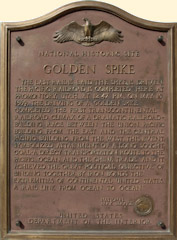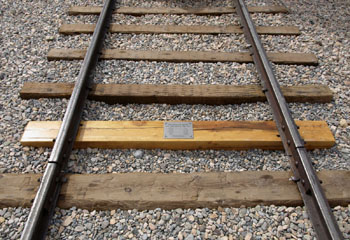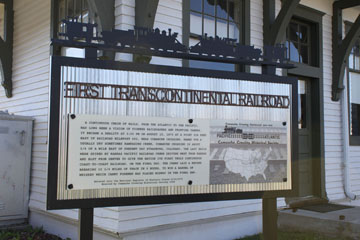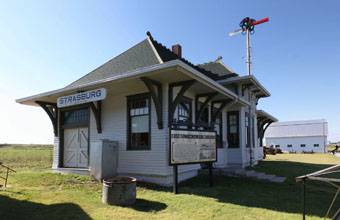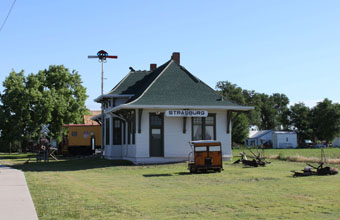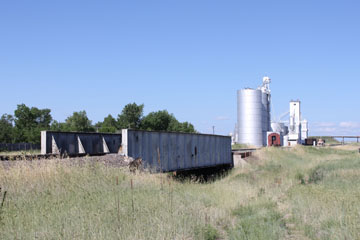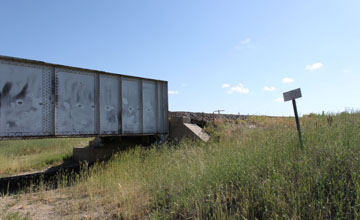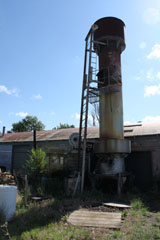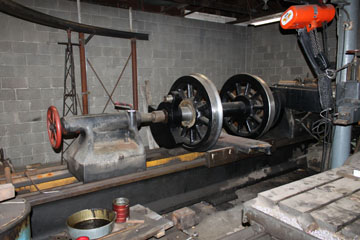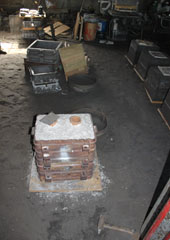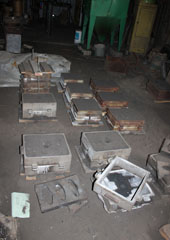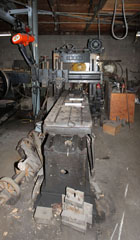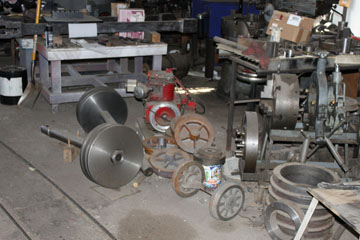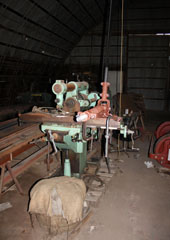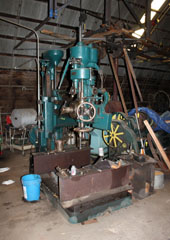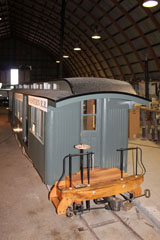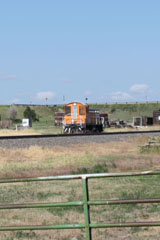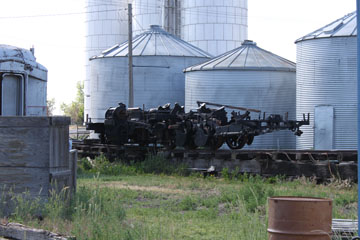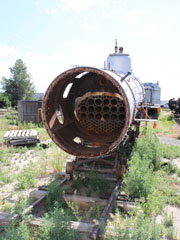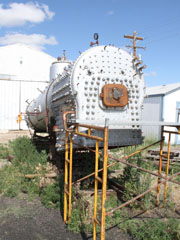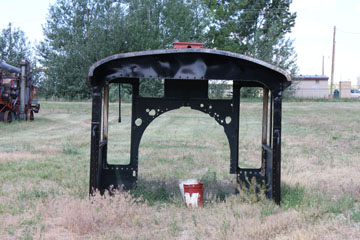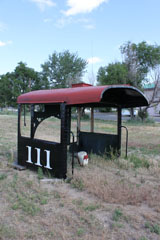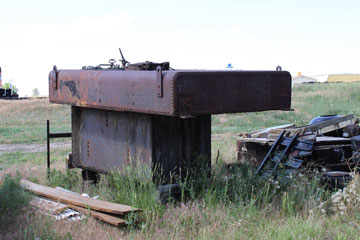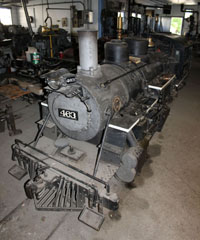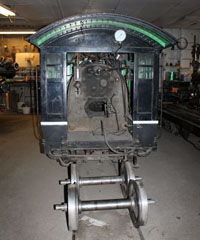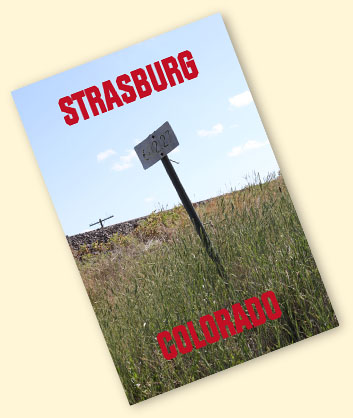

Why devote a page to Strasburg, Colorado, you might ask. Well, this little town has the distinction of being close to the place where
the first truly transcontinental US railroad link was forged. But, surely, that was at
Promontory, UT, in May 1869? Not so. To find out more, read on...
Strasburg is also home to the Uhrich Locomotive Works, an outfit owned by Marlin Uhrich that specialises in building and
restoring narrow gauge locomotives and
rolling stock, as well as building working models. Projects have included restoring Colorado & Southern 2-6-0 #9 for the Georgetown Loop at Silver Plume, CO, building a model of DRGW K-27 2-8-2 #463 and refurbishing ex Sundown & Southern 2-8-0 #111 also for the Georgetown Loop.

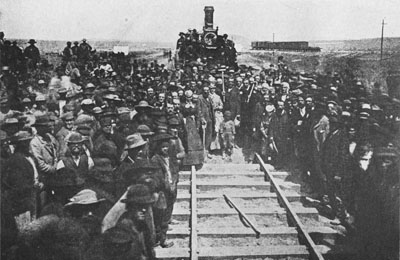
Above, "The Final Act" from Edwin L. Sabin, Building the Pacific Railway (1919). This photo, taken by A. J. Russell for Frank Leslie's Illustrated, has witnessed for many years the joining of the Central Pacific and Union Pacific at Promontory, UT, to complete the first US transcontinental railroad. It was taken at about 12.30 on the afternoon of 10th May 1869 just before the final spike had been slipped into its waiting hole.
Below, "The Engines Touch Noses", also from Sabin's Building the Pacific Railway, captures the ensuing champagne toasts moments later.
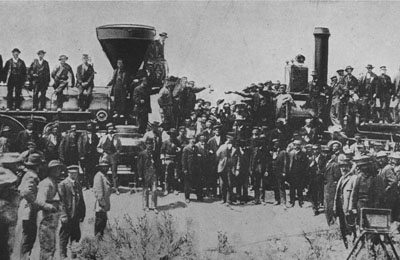
After WWII, interest revived and, in 1952, the Golden Spike Association held a re-enactment of the ceremony. The location became a National Historic Site in 1957 and came under federal ownership in 1965. In 1969, on the centennial of the original ceremony, twenty-eight thousand people attended and, today, Park Rangers invite visitors to do the deed for themselves by dropping a spike into a replica of the original tie with a replica plaque (below).
You can find out more about Promontory on the Golden Spike NHS page of this website.
Above, in 1916, the Southern Pacific Railroad, which had assumed control of the Central Pacific in 1885, erected a marker at the site to commemorate the Golden Spike ceremony.
By that time, however, except for local residents, the original event appears to have been all but forgotten.
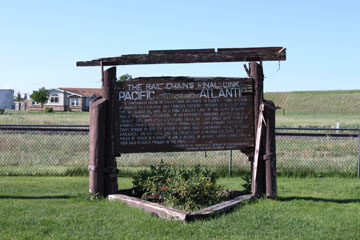
But, in reality, it would be nearly another three years before the Central Pacific/Union Pacific line would form a continuous transcontinental connection because, until March 1872, there was no bridge across the Missouri River linking Council Bluffs, IA, and Omaha, NE.
Instead, the honour goes to the Kansas Pacific Railroad, which completed a transcontinental connection at 3.00 pm on 15th August 1870 at an obscure spot then known as Comanche Crossing about twenty-five miles east of Denver in Colorado. The site is commemorated by a marker erected by the Union Pacific (above) which, ironically gained control of the Kansas Pacific in 1874 and absorbed it completely in 1880.
After the Chicago & North Western reached Council Bluffs in 1867, the Union Pacific for a time actually tried to run freight trains across the frozen Missouri River during the winter. It also used ferries but there were problems with the constantly shifting river bed and rough crossings, and it was clear that the lack of a bridge was a major impediment to effective operations. But, once completed, the bridge made Council Bluffs a major railroad centre, and a number of other railroads soon made connections to the city.
The first rail crossing of the Missouri between Kansas City, MO, and Kansas City, KS, Hannibal Bridge, was finished in July 1869. It joined the Hannibal & St. Joseph Railroad and points east through the Kansas Pacific to Denver. From there, the Denver Pacific connected to the Union Pacific at Cheyenne. So, when the "last spike" was driven at Comanche Crossing in August 1870, the first truly transcontinental railway was completed.
The settlement was renamed Strasburg that year in honour of a Kansas Pacific official.
A sign outside the depot building repeats the details on the UP commemorative marker.
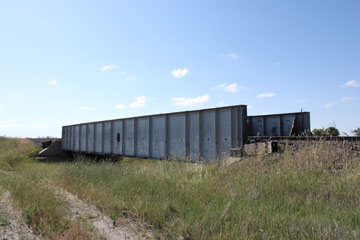
The sign states the final work involved laying 10½ miles of track in nine hours, more even than Crocker's "Chinese Pets" achieved a year earlier approaching Promontory, and was celebrated by cracking a cask of whiskey at the meeting point.
The meeting point was 928' east of milepost 602 at a "usually dry sometimes rampaging creek" and, although no-one we spoke to seemed to know the exact location, it may be the creek bed crossed by this modern girder bridge.

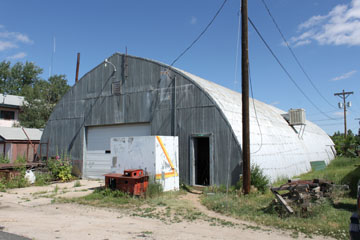

The Urich Locomotive Works is located on Railroad Street in Strasburg, CO.
The works was started by Virgil Urich in 1945 with construction of a 14" gauge live steam locomotive in a small foundry and machine shop. By 1948 the shop had become known throughout the area as the place to go for equipment repair and welding jobs. Marlon Uhrich, Virgil's son, later joined the business and moved it across the street to larger quarters to accommodate a fabricating shop (top), machine shop (lower photo) and a foundry (photos on the right).
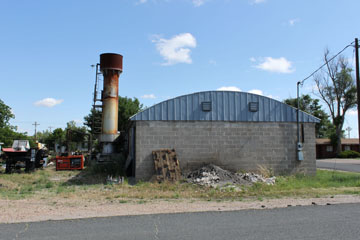
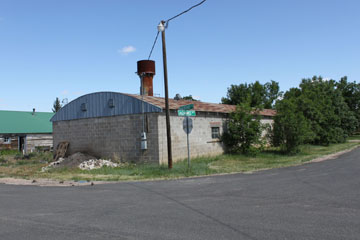
Coal and pieces of scrap metal are loaded by the bucket-type elevator into the "cupola" at the top of the tower (above and left). The heat from the coal fire builds up, melting the metal.
The molten metal is then run out of the furnace via a concrete and brick channel (above right).

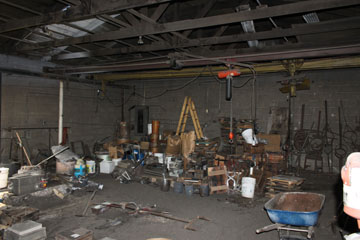
The molten metal is then poured into specially constructed sand moulds (below).
A pattern in the shape of the part to be cast is covered with fine soft moulding sand and rammed down tightly in a wooden "flask". The top is then filled with more sand and rammed down. Openings are drilled down through the sand to the pattern, one to pour the molten metal and others to allow air in the moulding to escape. The top flask is lifted off, the pattern carefully removed, and the top replaced. The metal is then poured into the hollow left by the pattern.
Left, above and upper right, the foundry, machine shop and fabricating shop are equipped with all the tools and machines required of a small modern railroad workshop.
Right, jobs included working on the truck and traction motors of a standard gauge diesel-electric locomotive.
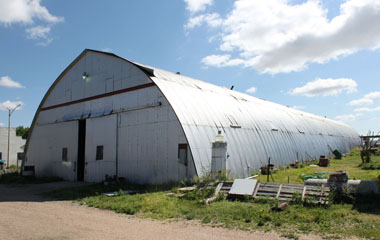
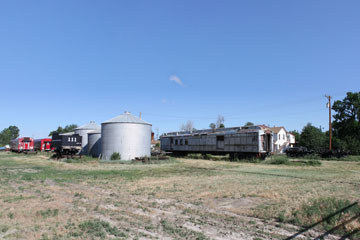
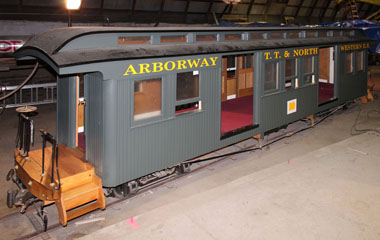

Across the street in a large Quonset hut, a 15" gauge wooden car was nearing completion for the Arborway, T.T. & Northwestern Miniature Railroad.
This private railroad located in South Central Missouri between Steelville and St. James, MO. It is not open to the public.
Above, there were several passenger coaches in various states of repair parked in the yard behind the Quonset hut, as well as locomotive parts.
And, right, parked beside the Union Pacific main line next to a grain silo was ex-PFE EMD NW2 #1048.

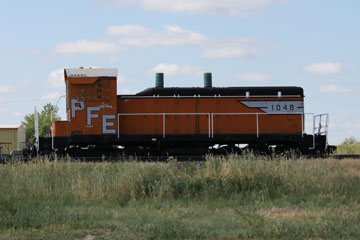
#1048 was built by EMD in 1946 for the Union Pacific and was in service until October 1974. It was then sold to UP's subsidiary Pacific Fruit Express Company, co-owned by the Southern Pacific, and started work at the PFE facility in Roseville, CA. However, it spent most of its working life at PFE in Tucson, AZ.
In the 1980s, after the owners split the company, #1048 continued to work for SPFE (Southern Pacific Fruit Express). When the merger with the Union Pacific occurred, it returned to UP ownership. In 1998, #1048 was bought by a private owner and moved to Strasburg, where it has stood ever since awaiting rebuilding.
One thousand, one hundred and twenty-one NW2s were built for US railroads and twenty-four for Canadian railroads from 1939 to 1949. With a 12 cylinder EMD 12-567 prime mover powering a GM D15C generator to drive four GM-D37 traction motors, the 248,000 lb NW2 developed 31,000 lbs continuous tractive effort at 11 mph with a top speed of 65 mph. You can see other NW2s on the Pennsylvania Railroad Museum Yard page of this website, the Virginia Museum of Transportation page and the Monticello Railway Museum page.

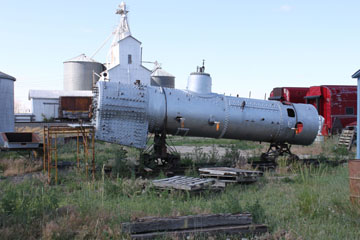
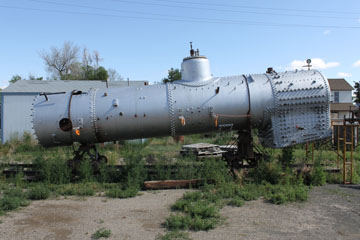
International Railways of Central America #111
was still undergoing restoration when we visited. On the left, the frame, drivers, valve gear and cylinders. Above and right, the boiler after having a paint job.
The locomotive was built as #116 by Baldwin in 1926 and renumbered #111 in 1928. Bought from the FIdeCA by Don Drawer, owner of the
Sundance & Southern Railway in 1972, in 2002, the city of Breckenridge bought it from an auction of the S&S equipment intending to operate their own railroad.

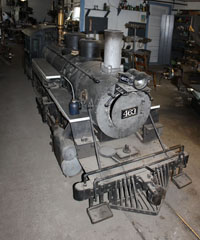
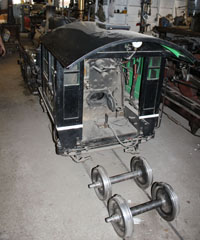
Inside the machine shop was a 15" gauge model of DRGW K-27 #463.
The K-27s were built as Vauclain compounds, but were soon converted to single expansion. Later, #452-#456, #458, #459, #461, #463 and #464 were fitted with superheaters, piston valves and Walschaert valve gear.
The original #463 was owned by Gene Autry from 1955 to 1972. It was donated to City of Antonito, CO, in 1972, restored and put into service on the Cumbres & Toltec Scenic Railway in 1994.
You can see it on the Cumbres & Toltec Scenic Railway page on this website.



